Study on Acid Phosphatase Enzyme Activity in Semen Mixed with Various Body fluids
Ajay Singh Rana1*, Priyanka Verma2, Hiren Vekariya3 and Priyanka Mittal1
1Research Scholar, University Institute of Applied and Health Sciences, Chandigarh University, India
2Assistant Proffessor, University Institute of Applied and Health Sciences, Chandigarh University, India
3Lovely Professional University, India
Submission: April 08, 2018; Published: May 03, 2019
*Corresponding author:Ajay Singh Rana, Research Scholar, University Institute of Applied and Health Sciences, Chandigarh University, Gharuan Punjab, India
How to cite this article: Ajay SR, Priyanka V, Hiren V, Priyanka M. Study on Acid Phosphatase Enzyme Activity in Semen Mixed with Various Body Fluids. J Forensic Sci & Criminal Inves. 2019; 11(5): 555823. DOI: 10.19080/JFSCI.2018.11.555823.
Abstract
In case of sexual offences the dry seminal stains are encountered in variety of forms on victims and accused clothes, on the body and on the spot where sexual offence had occurred. Acid phosphatase test is one of the most common tests used by forensic laboratories for the detection of semen. Sometimes in sexual offences the seminal fluid got mix with various other body fluids. Therefore, its detection after mixing with other body fluids is one of the most challengeable tasks for forensic laboratories by using acid phosphatase test. Various studies conducted on acid phosphatase enzyme showed that it is not specific to semen and can also be found in other body fluids. The purpose of this study is to show the activity of acid phosphatase enzyme in semen after interference with other body fluids by serial dilutions method. In this study we have collected semen samples from six donors and then serial diluted with various body fluids and then there activity was checked for acid phosphatase enzyme activity.
Keywords: Body fluids; Semen; Acid phosphatase; Menstrual blood
Introduction
Human semen consists of spermatozoa, seminal plasma and epithelial cells. The seminal plasma is a mixture of secretions derived from the male accessory reproductive organs like epididymis, seminal vesicles, the prostate, vasa-deferantia, bulbourethral and urethral glands [1]. The precise and efficient detection of semen and saliva in sexual assault case-work items is a critical step in the forensic science. Semen detection is usually based on the activity of acid phosphatase (AP), an enzyme found in high concentration in the seminal plasma [2,3]. SAP is a glycoprotein having molecular weight of 10,0000 to 120,000. It is a dimeric protein made up of two subunits of 50000 to 55000 dalton of molecular weight and a nonspecific orthophosphoric monoester phosphohydralase, which catalyses the hydrolytic removal of an ester linked phosphate group from a monophosphate substrate with an optimal pH of 4.9 [4]. The method currently accepted by operational forensic science laboratories allows 2 min for a reaction to be obtained, and until relatively recently, this has not been challenged [5]. Acid phosphatase enzyme is found in seminal fluid in high concentrations as compared to other body fluids and is water soluble enzyme [6].
The Acid Phosphatase (AP) Brentamine test for the presence of semen is detected either by direct testing or indirect testing of a questioned extractor on a surface for the presence of semen. For direct testing a drop of extract is placed onto filter/blotting paper. In case of indirect testing a visible possible semen stain is pressing with dampened filter/blotting paper on to the surface to transfer some seminal fluid onto the paper. The filter/blotting papers are then tested with a chemical reagent, which changes colour from orange to purple in the presence of acid phosphatase. This is due to hydrolysis of the α-napthylphosphate to produce α-napthol, which couples with a Brentamine Fast Black/Blue salt, resulting in a purple azo dye [7-12].
The detection of acid phosphatase can be best achieved by direct testing rather than detection of AP from the extract of swab [13]. Sometimes exhibits seized for forensic examinations have been washed before send to forensic laboratories. Sarah Noel, et al. [14] in their study utilized commonly screening tests for the detection of semen on washed fabrics. They also showed that the semen stains washed once shows positivity for AP test in only 15% of cases and strongly positive in 2% of cases [14]. Ashley et al. [15] in their study showed that there is persistence of spermatozoa on cotton and terry towel even after six wash cycles. Therefore, they emphasizes in their study that washed clothes must be examined even they have washed multiple times [15].
When the semen is diluted or mixed with other body fluid then it behaves differently. Therefore, the detection of acid phosphatase activity is critical under such circumstances for the interpretations of sexual offences cases [12]. Hooft and Voorde [16] in their study showed that 5 out of 50 samples for whole blood, none out of 50 urine samples and 1 out of 50 samples showed positive results for Acid Phosphatase test. Therefore, in their study they showed that positive acid phosphatase results must be interpreted with great caution and this only indicated that stain must be retained for further investigations [16].
Allery et al. [17] in their study showed that acid phosphatase enzyme test has good sensitivity and sensitivity and has a negative predictive value of 98%. Thus, acid phosphatase tests used as a screening test rather than a confirmatory test. Acid phosphatase used to semen detection is not 100% reliable as the acid phosphatase is present in other biological material which is a semen free like semen free vaginal material, faeces and other food stuffs which can produce false reactions. Although the concentrations of acid phosphatase enzyme is significantly higher in seminal fluid as compared to other biological material [5].
Recently various techniques have been developed for identification of semen such as Lumatic Superlight 400, XRF (Zinc), PRM1, PRM1/PRM2, KLK (RT-PCR), RSID-semen test & nanotrapSg [18]. Acid phosphatase test is not a confirmatory test for semen detection. The confirmation of semen is done through microscopic examinations by identification of spermatozoa. The human sperm is a flagellated cell with its head about 4-5 μm long and 2-3 μm wide. The sperm had a long tail of about 50-55 μm in length [19].
Material and Methods
We have performed experiments for the detection semen by acid phosphatase enzyme activity by diluting with various body fluids.
Preparations and analysis of samples for serial dilutions
Collection of samples: Six samples each of human seminal fluid, urine, blood from male volunteers who were neither connected in blood relation neither showed hereditary to each other were collected. Six samples of female menstrual blood were also collected from human female’s volunteers who were also not related in blood relations with each other. The samples were preserved in culture tubes and placed in refrigerator at -4 0C for further analysis.
Preparation of acid phosphatase solution
0.2 gm of sodium acetate and 0.1 ml of acetic acid was taken into a conical flask and stirred with glass rod until dissolved. Then 0.025 gm brentamine fast blue B salt was added and covered with aluminum foil and heated in water bath for two minutes to dissolve. Then 0.0125 gm sodium α naphthyl phosphate was added and stirred to dissolve. Then 10 ml distilled water was added into the solution. Then solution was placed in amber colour bottle for further analysis [20].
Serial dilution of seminal fluid mixed with various body fluids
A series of dilutions of semen, semen mixed with fresh blood, semen mixed with menstrual blood and semen mixed with urine (neat, 1/2, 1/4, 1/8, 1/16, 1/32, 1/64, 1/128, 1/256, 1/512, 1/1028) by using distilled water were performed. These dilutions were done in a cavity tiles by transferring the solutions with the help of micropipette to the adjacent well. A drop of each dilution was applied on the whatman grade 1 filter paper and allowed to air dried at room temperature for two hours and marked as per dilutions. The marked whatman filter papers having seminal stains then added with a 100μl acid phosphatase solution and change in colour and time of reaction was noted down. Two minute cut off time was fixed for the detection of colour change, beyond two minute the results were declared negative.
Detection of Seminal stains mixed with various body fluids by acid phosphatase test
The record of reaction occurred was noted on the basis of the purple colour formed. The colour of reaction formed was categorized on the basis of purple colour obtained like strong purple, purple, faint purple, very faint purple and negative. This process was repeated for all the six samples utilized for serial dilutions by various body fluids.
Results
Results of the samples after serial dilutions
Limit of detection
In the present study detection of semen in six samples mixed with various body fluids were diluted by serial dilutions method. All the observations made were mentioned in Table-1 and 2. The results of our study showed that detection of seminal fluid was done within 15 sec by acid phosphatase test and as the dilutions steps increases the time of reaction is also increases. The purple colour formed during the reaction gets fades away as the dilution progress from strong purple, purple, faint purple, very faint purple and negative. The results of our study showed that semen sample can be detected maximally up to 1/512 dilutions in samples no. 1-6 and up to 1/256 in sample no. 1 &3. Semen sample mixed with urine sample was detected for acid phosphatase activity up to 1/128 in sample no. 1,2,4 & 6 and up to 1/256 dilutions in sample no. 3 & 5. Semen sample mixed with blood sample was detected for acid phosphatase activity up to 1/128 in sample no. 1-6. Semen sample mixed with menstrual blood was detected up to 1/128 in sample no. 1 & 2 and up to 1/64 in sample no. 3-6.
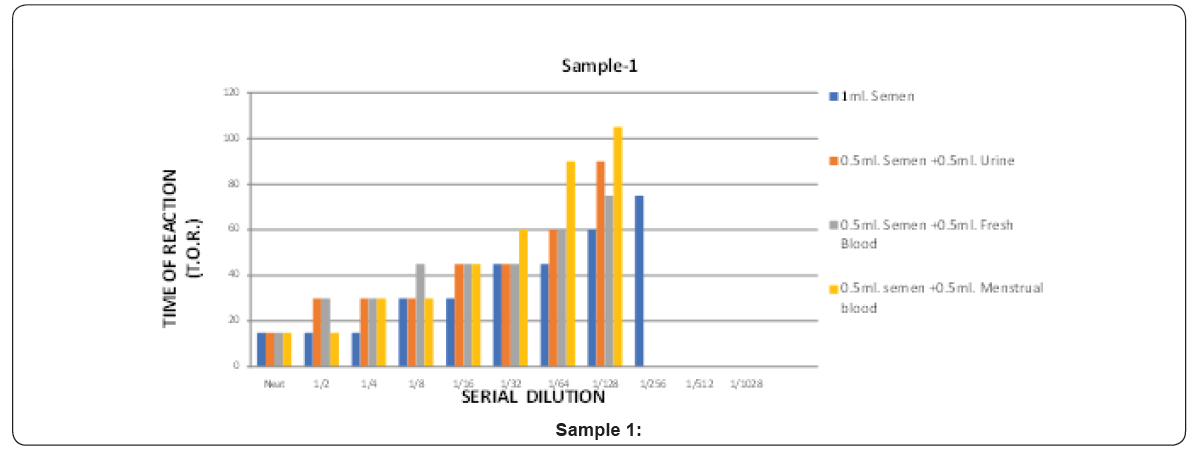
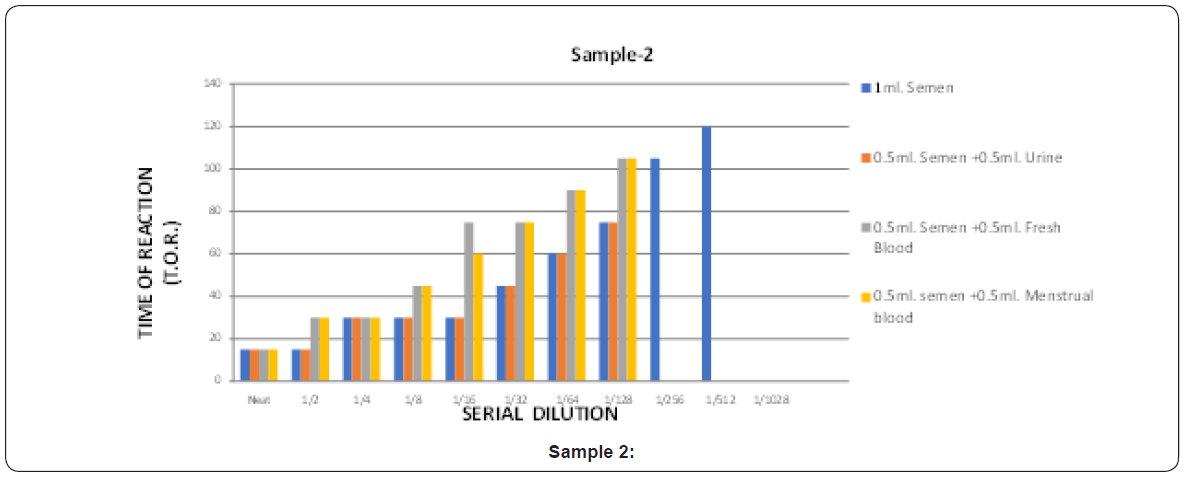

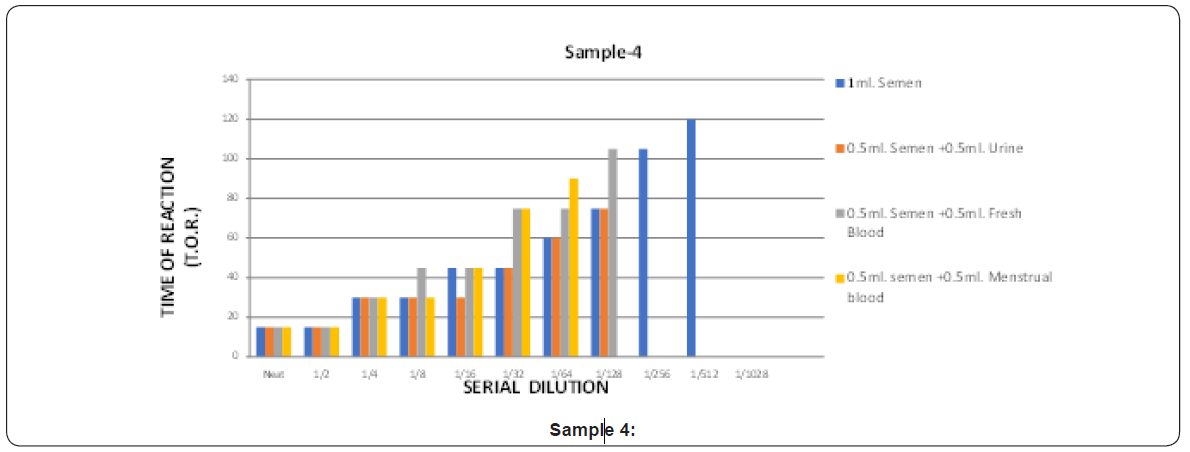

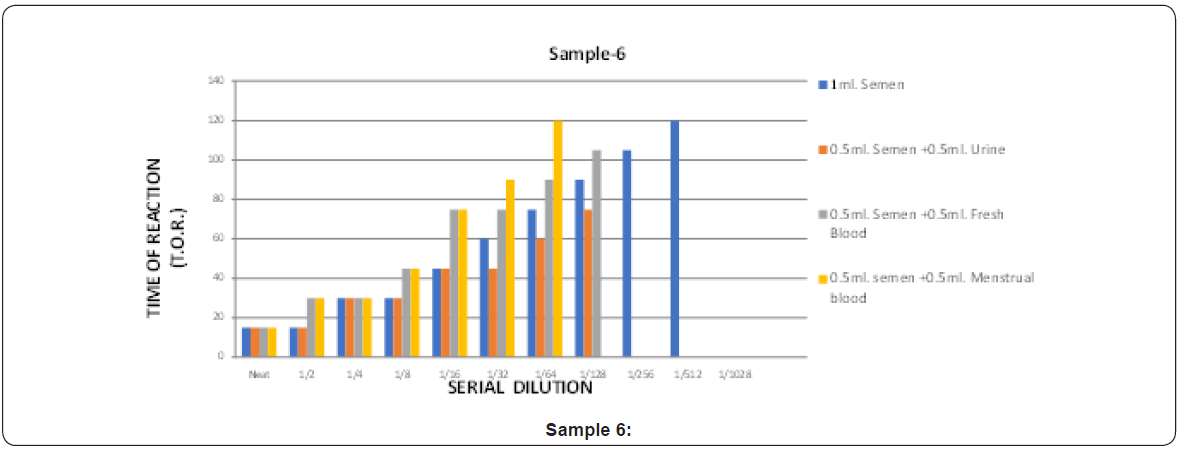
Time of reaction
Time of reaction is the time period between the addition of acid phosphatase solution in the stain and appearance of purple colour in the sample. In the present study no result was detected in the samples after 120 sec. Out of the 264 samples studied after serial dilutions with various body fluids 37 samples gave positive reaction within 15 sec, 54 samples gave positive results in 30 sec, 38 samples in 45 sec, 17 samples in 60 sec, 23 samples in 75 sec, 14 samples in 90 sec, 13 samples in 105 sec, 5 samples in 120 sec and negative in 63 sec respectively (Table-1).

Change in colour
Reaction time was recorded in every 15 sec on the basis of colour change. Reactions were recorded on the basis of strength of purple colour formed during the acid posphatase reaction. The change in colour reaction was noted and categorized as strong purple (+++), purple (++), faint purple (+), very faint purple (+) and negative (-) (Table-2 & Figure-1). In our study the change in colour was strong in neat samples but as the dilutions progressed the color becomes faint and finally no colour change was observed after 1/512 dilutions.
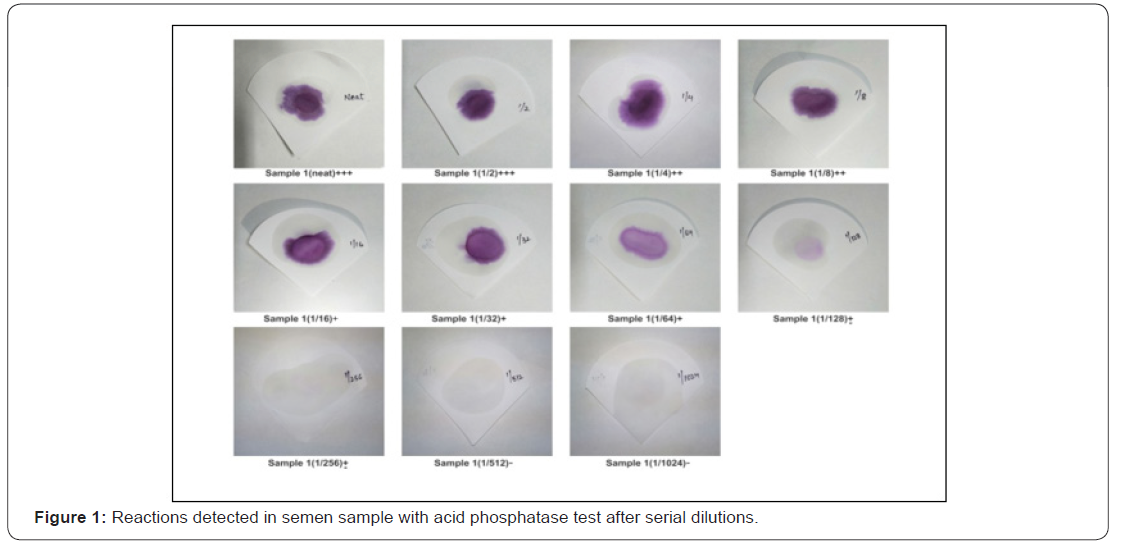
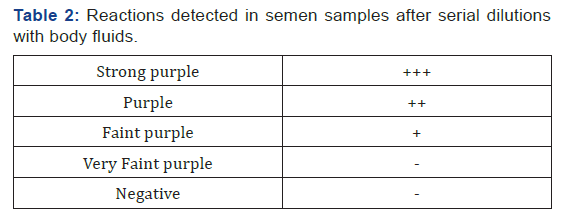
Discussion
From the Table 1 it can be seen that the majority of semen samples tested for acid phosphatase activity by serial dilutions works up to 1/512 dilutions maximally and 1/256 minimally. Similarly, semen mixed with urine works maximally at 1/256 and minimally at 1/128 dilutions, semen mixed with blood works maximally at 1/128 and semen mixed with menstrual blood works maximally at 1/128 and minimally at 1/64. Similar study have also done Bhoopendra Singh et al. [20] in semen sample who showed that maximum detection limit was 1/512 and minimum was noticed 1/64. These sets of experiments have identified the potentiality of acid phosphatase enzyme in semen after mixing with various body fluids. Redhead and Brown in their study showed that acid phosphatase activity was detected positive up to 1/1000 dilutions by direct testing and 1/400 by using the press method. In their study no reaction was observed after 1/400 dilutions by press method and 1/1000 dilutions by direct method [5]. Allard et al. [13] in their study showed that acid phosphatase test was detected strong to moderate up to 1 in 25 dilutions. The study made was found variable from other two laboratories where strong positive results were detected in 1 in 200 dilutions and other obtained a weak or negative results after 1 in 40 dilutions [13].
In our study time of reaction in 201 samples out of 264 samples tested for acid phosphatase test varied from 15 sec to 120 sec. 37 samples (14.01%) were tested positive with in 15 sec, 54 samples (20.45%) in 30 sec, 38 samples (14.39%) in 45 sec, 17 samples (6.43%) in 60 sec, 23 samples (8.71%) in 75 sec, 14 samples (5.30%) in 90 sec, 13 samples (4.92%) in 105 sec and 5 samples (1.89%) in 120 sec. Davidson and Jaloweicki [12] in their study on 34 different types of fabrics showed that acid phosphatase reaction time on top blot was from 1 sec to 90 sec and on bottom blot was from 1 sec to 120 sec [12]. Redhead & Brown [5] in their study showed that time of reaction varied from 1 min to 16 min from neat to a sample diluted up to 1/1000. In their study they also showed that concentration of acid phosphatase varies with in the different donors and also the replicated samples from the same donar. Lewis et al. [11] in their study showed that most brands of filter paper used to detect semen by acid phosphatase test can detect up to 1 in 40 dilutions [11].
From the results it’s a clear that as the semen becomes more diluted the time of a reaction is increased significantly. Moreover, a significant difference was observed between the neat samples and when the samples are diluted which signifies the weakness of Acid Phosphatase enzyme activity (Figures 1-7).
Conclusion and Summary
The identification of body fluids is very important as it is very informative for linking the victim and suspect with crime to aid in forensic investigation. From this study it is concluded that there is correlation between the acid phosphatase enzyme activities with the serial dilutions of semen samples with various body fluids. As the dilutions progresses the time of reaction also increases. The results of our study showed that when the semen get mixed with other body fluids the dilutions limit to which acid phosphatase enzyme can be detected also decreases significantly. Acid phosphatase test is commonly used by forensic laboratories for screening the forensic exhibits for further examinations. The positivity of acid phosphatase test is based on the development of purple colour within two minutes. As other biological fluids also contained acid phosphatase enzyme and thus further testing is required for the confirmation of seminal stains. Since other body fluids may also contains acid phosphatase enzyme but in lower concentrations as compared to semen. Thus, acid phosphatase test is a presumptive test for the semen detection and further testing is required for the confirmation of semen. Although the limitations of acid phosphatase test are widely known but still it is utilized by forensic laboratories for the screening of semen in forensic exhibits
References
- Harel VS, Khairkar SR, Kulkarni KV, Malve MK (2015) Detection of Semen Stains in Rape Cases by a Very High Powered UV-VIS Light Source, Facilitated Conviction of Accused Person. J Forensic Res 6: 290.
- Yael Herman, Ilan Feine, Ron Gafny (2018) Acid phosphatase test on Phadebas® sheets- An optimized method for presumptive saliva and semen detection. Forensic Sci Int 288: 218-222.
- Lewis J, Baird A, McAlister C, Siemieniuk A, Blackmore L, et al. (2013) Improved detection of semen by use of direct acid phosphatase testing. Sci Justice 53(4): 385-394.
- Chang ME (2011) A comparison of rapid stain identification of test for semen (RSIDTM-Semen) Seratec® personal assistant Semiquent and ABA card p30 tests for the forensic identification of seminal fluid. California state University, Los Angeles, USA.
- Paul Redhead, Melanie K Brown (2013) The acid phosphatase test two minute cut-off: An insufficient time to detect some semen stains. Sci Justice 53(2): 187-191.
- Diem K, Lentner C (1970) Scientific Tables (DocumentaGeigy), (7th edn) Ciba-Geigy, Basle.
- S Kaye (1949) Acid Phosphatase Test for the presence of seminal fluid. The Journal of Laboratory and Clinical Medicine 34: 728-732.
- F Lundquist (1950) Medicolegal identification of seminal stains using the Acid Phosphatase Test. AMA Arch Pathol 50(4): 395-399.
- S Kind (1957) The use of the acid phosphatise test in searching for seminal stains. Journal Criminal Law, Criminology and Policing Sciences 47: 597-600.
- S Kind (1965) The Acid Phosphatase Test. In: AS Curry (Eds.), Methods in Forensic Science. Interscience Publishers, New York, USA 3: 267-288.
- Lewis J, Jones S, Baxter F, Siemieniuk A, Talbot R (2012) The fallacy of the two minute acid-phosphatase cut off. Sci Justice 52: 76-80.
- Davidson G, Jaloweicki TB (2012) Acid phosphatase screening-wetting test paper or wetting fabric and test paper?. Sci Justice 52(2): 106-111.
- Allard JE, Baird A, Davidson G, Jones S, Lewis J, et al. (2007) A comparison of methods used in the UK and Ireland for the extraction and detection of semen on swab and cloth samples. Sci Justice 47(4): 160-167.
- Noël S, Lagacé K, Raymond S, Granger D, Loyer M, et al. (2019) Repeatedly washed semen stains: optimal Screening and sampling strategies for DNA analysis. Forensic Sci Int Genet 38: 9-14.
- Nolan A, Speers SJ, Murakami J, Chapman B (2018) A pilot study: The effects of repeat washing and fabric type on the detection of seminal fluid and spermatozoa. Forensic Sci Int 289: 51-56.
- Hooft PJ, Van de Voorde HP (1994) Interference of body products, food and products from daily life with the modified zinc test and acid phosphatase test. Forensic Sci Int 66(3): 187-196.
- Allery JP, Telmon N, Blanc A, Mieusset R, Rougé D (2003) Rapid detection of sperm: comparison of two methods. J Clin Forensic Med 10(1): 5-7.
- Virkler K, Lednev IK (2009) Analysis of body fluids for forensic purposes: from laboratory testing to non-destructive rapid confirmatory identification at a crime scene. Forensic Sci Int 188(1-3): 1-17.
- Saferstein R (2005) Forensic Science Handbook, Volume II, (2nd Edn). Pearson Education Incorporate 1: 331-360.
- Bhoopendra Singh, IlaGautam, Vijay Kumar Yana, Braja Kishore Mohapatra (2014) Detection of human seminal stains in one minute by modified acid phosphatase test. European Journal of Forensic Science 2(3): 14-18.






























